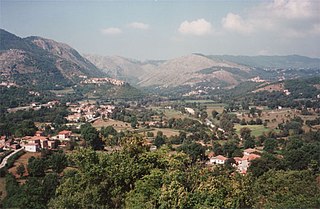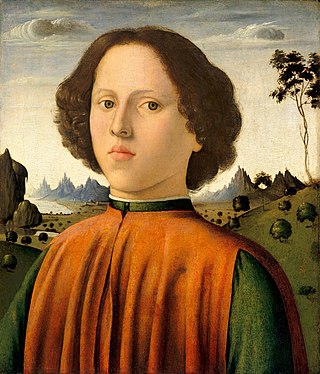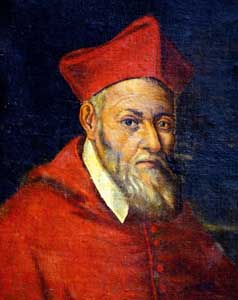This article has multiple issues. Please help improve it or discuss these issues on the talk page . (Learn how and when to remove these messages)
|


The Duchy of Alvito was a fiefdom of the Kingdom of Naples, in southern Italy.
This article has multiple issues. Please help improve it or discuss these issues on the talk page . (Learn how and when to remove these messages)
|


The Duchy of Alvito was a fiefdom of the Kingdom of Naples, in southern Italy.
The Cantelmo family, of French origins, arrived in Italy in the 13th century around the time the Angevins conquered Naples (1266). From the Angevins, the Cantelmo received several castles and fiefs around Alvito in what is now the Valcomino, dominated by the numerous fiefs of the powerful regional monasteries (such as Monte Cassino and San Vincenzo al Volturno), as well as by the rival family of the Counts of Aquino. Rostaino and his successors tried unsuccessfully to extend their control over the whole region in the 14th century. They sided with Queen Joan II of Naples but were defeated by the troops of Charles of Durazzo. In a document of 1384, Giacomo IV is mentioned as "lord of the lands of Alvito".
During the turmoil caused by the succession of Ladislaus of Naples, the Cantelmo sided with his rival, Louis II of Anjou. Rostainuccio ("little Rostaino") was defeated and captured by Jacopo Orsini at Pereto in Abruzzo in 1369, and Alvito was granted by Ladislaus to Andrea Tomacelli, brother of the Count of Sora and of Pope Boniface IX. Alvito was soon returned to the Cantelmo, and Giacomo V, Rostainuccio's son, was the first ruler of Alvito to bear the title of count. He likely obtained the title as a dowry from his wife, Elisabetta d'Aquino. After Giacomo's death the county was expanded by his son Antonio, who acquired Gallinaro, Fontechiari, Arce, Popoli (this from his brother Francesco, who had died heirless), and other lands in the Abruzzo and Valcomino. Antonio's rule was troubled by the turmoil and succession crises of the Kingdom of Naples in the early 15th century, and he lost his lands repeatedly. His son Nicolò was able to establish his rule more firmly by backing the successful Alfonso V of Aragon in his conquests of 1443. Alfonso created Nicolò Duke of Sora, and in this capacity he stripped his brother Onofrio of the County of Popoli in Abruzzo. Nicolò also obtained the position of royal counselor in 1452 and, just before his death, his title was raised to Duke of Alvito.
Nicolò's son Piergiampaolo inherited Sora and Alvito, while another son, Piergiovanni, inherited Popoli. Piergiampaolo soon annexed his brother's Abruzzese lands and, after siding against the new king, Ferdinand I, in the revolt of 1460, captured the territories of Montecassino, Arce, and the fiefs of the Colonna in Abruzzo. He also took part in the sieges of Sulmona and L'Aquila, but was in turn besieged and defeated by Napoleone Orsini at Sora. As a result, he was forced to cede Sora, Arpino, Casalvieri, Isola del Liri, and Fontana Liri to the Papal States in 1463. His duchy was downgraded to a county, the title being assigned to Piergiovanni. At the same time, Alvito and Sora were given the right to mint cavalli (a type of coin). Piergiampaolo organized a second plot against Ferdinand, but was again defeated and had to abandon hopes in returning to Alvito. Exiled to France, he returned with the invading army of Charles VIII of France during the War of 1494–95. With his brother, Sigismondo II of Sora, he re-conquered most of his lands. He was able to resist the Neapolitans after the French retreat, but in 1496 Sora fell to Frederick I of Naples, followed in 1496 by Alvito, captured by general Gonzalo de Córdoba. This put an end to the Cantelmo rule.

The Valcomino became a royal demesne. In 1497 Gioffre Borgia, son of Pope Alexander VI, was invested with the title Count of Alvito. During the War of 1499–1504, when Louis XII of France tried to conquer Naples, Gioffre sided with the French, but captured by Prospero Colonna he sided with the Spanish, which caused a rebellion in Alvito. He sent the condottiero Fabrizio Colonna to stabilise his lands, to which he finally returned in 1504. After the death of his wife, Sancha of Aragon, he lost the rights to the county, which were given in 1507 to the Spanish general Pietro Navarro.
In 1515, after Pietro had embraced the French cause, Alvito was conferred on the viceroy Ramón (Raimondo) de Cardona, who did not live there but rather administered it through a governor. The county was inherited by Ramón's son Folch (or Ferrante), under the regency of his mother, Isabella de Requesens. She was able to exploit the ongoing Franco-Spanish wars to acquire the nearby Duchy of Somma. Ferrante was succeeded in 1571 by his sons Loise (1572–74) and Antonio (1574–92), who let Alvito decline under ruthless local governors. Despite the acquisition of the Duchy of Sessa, in 1592, the county was ceded to Matteo di Caua for 100,000 ducats. It was sold a second time to the Milanese nobleman Matteo Taverna, who acquired it with money from Tolomeo II Gallio, nephew and namesake of the Cardinal Tolomeo Gallio. In the end Tolomeo obtained full rule in Alvito, receiving the title of Duke in 1606 from Philip III of Spain. [1]
The Gallio family held the duchy until 1806, when feudalism was suppressed in the Kingdom of Naples.

The House of Orsini is an Italian noble family that was one of the most influential princely families in medieval Italy and Renaissance Rome. Members of the Orsini family include five popes: Stephen II (752–757), Paul I (757–767), Celestine III (1191–1198), Nicholas III (1277–1280), and Benedict XIII (1724–1730). The family also included 34 cardinals, numerous condottieri, and other significant political and religious figures. The Orsini are part of the Black nobility who were Roman aristocratic families who supported the Popes in the governance of the Papal States.

Ferdinand I, also known as Ferrante, was king of Naples from 1458 to 1494.

Sora is a town and comune of Lazio, Italy, in the province of Frosinone. It is built in a plain on the banks of the Liri. This part of the valley is the seat of some important manufacturing, especially of paper mills. The area around Sora is famous for the costumes of its peasants.

Ladislaus the Magnanimous was King of Naples from 1386 until his death and an unsuccessful claimant to the kingdoms of Hungary and Croatia. Ladislaus was a skilled political and military leader, protector and controller of Pope Innocent VII; however, he earned a bad reputation concerning his personal life. He profited from disorder throughout Italy to greatly expand his kingdom and his power, appropriating much of the Papal States to his own use. He was the last male of the Capetian House of Anjou.

Alvito is a town and comune in central Italy, in the province of Frosinone, south of Rome in the Lazio region. Its territory is included in the Abruzzo, Lazio and Molise National Park.

Arce is a comune (municipality) in the province of Frosinone, in the region of Lazio, Italy. it is an agricultural centre located on a hill overlooking the Via Casilina, in the Latin Valley and in the middle valley of the Liri.

The Valle di Comino is a valley in the province of Frosinone, Lazio, in central Italy. It runs from San Biagio Saracinisco to Vicalvi and is adjacent to the Abruzzo mountains. It grossly corresponds to the upper valley of the Melfa river, which runs through it before joining the Liri.

Isola del Liri is an Italian town of Lazio, Italy, in the province of Frosinone. As its name implies, Isola is situated between two arms of the Liri. The many waterfalls of this river and of the Fibreno are used by factories.

The Duchy of Sora was a semi-independent state in Italy, created in 1443 by King Alfonso I of Naples and dissolved in 1796. It occupied the south-eastern part of what is today Lazio, bordering what is now Abruzzo. Its capital was first Sora, and later, under the Boncompagni family, Isola di Sora.

Campo di Giove is a town and comune in the province of L'Aquila in the Abruzzo region of central Italy. Its territory is included in the Majella National Park. Located at the foot of the southwestern slope of the Majella, it is a holiday resort in summer and winter, thanks to the presence of a ski station. In English, its name means 'Campus Jovis'.

Popoli Terme is a comune and town in the province of Pescara, in the Italian region of Abruzzo.

Jacopo Caldora or Giacomo Caldora was an Italian condottiero.

Don Giacomo I Boncompagni was an Italian feudal lord of the 16th century, the illegitimate son of Pope Gregory XIII. He was also Duke of Sora, Aquino, Arce and Arpino, and Marquess of Vignola.

Gioffre Borgia, also known as Goffredo (Italian), or Jofré Borja (Valencian), was the youngest illegitimate son of Pope Alexander VI and Vannozza dei Cattanei, and a member of the House of Borgia. He was the youngest brother of Cesare, Giovanni, and Lucrezia Borgia.

Tolomeo Gallio was an Italian Cardinal.

Giovanni della Rovere was an Italian condottiero. He was a nephew of Pope Sixtus IV, and the brother of Giuliano della Rovere (1443–1513), Pope Julius II from 1503.

The House of Acquaviva is an aristocratic Italian family from Naples. The head of the family was Duke of Atri in the Abruzzo from the 15th century, and Count of Conversano after an Orsini family marriage in 1546, among other titles.
Conrad of Antioch was a scion of an illegitimate branch of the imperial Staufer dynasty and a nobleman of the Kingdom of Sicily. He was the eldest son of Frederick of Antioch, imperial vicar of Tuscany, and Margherita di Poli. He was thus a grandson of the Emperor Frederick II, a nephew of King Manfred of Sicily (1258–66) and cousin of King Conradin (1266–68). His surname, which is contemporary, comes from his paternal grandmother, a mistress of Frederick II from Antioch. He may be called "Conrad I" to distinguish him from his descendants with the same given name.
Don Carlo II di Tocco Cantelmo Stuart, or Carlo di Tocco for short, was an 18th/19th-century Italian noble, serving as the Prince of Montemiletto and the titular Prince of Achaea, among other titles, from the death of his father Restaino di Tocco Cantelmo Stuart in 1796 to his own death in 1823. In addition to holding various fiefs throughout Italy, Carlo also rose to prominent positions within the Kingdom of Naples and its successor state, the Kingdom of the Two Sicilies. In 1808, he came one of the earliest knights of the Royal Order of the Two-Sicilies and from 1821 to 1823, he served as a Councillor of State in the Kingdom of the Two Sicilies.
Don Francesco di Paola Mariano Luigi di Tocco Cantelmo Stuart, or Francesco di Tocco for short, was an 18th/19th-century Italian noble, serving as the Prince of Montemiletto and the titular Prince of Achaea from the death of his father Carlo II di Tocco Cantelmo Stuart in 1823 to his own death in 1877. Francesco was high-ranking among the nobility of the Kingdom of the Two Sicilies, serving as a governmental and military official, and was a knight of three different orders of knighthood.